
Terni is a city in the southern portion of the region of Umbria in central Italy. The city is the capital of the province of Terni, located in the plain of the Nera river. It is 104 kilometres northeast of Rome and 81 km south of the regional capital, Perugia.

The Apostolic Palace is the official residence of the pope, the head of the Catholic Church, located in Vatican City. It is also known as the Papal Palace, the Palace of the Vatican and the Vatican Palace. The Vatican itself refers to the building as the Palace of Sixtus V, in honor of Pope Sixtus V, who built most of the present form of the palace.

Todi is a town and comune (municipality) of the province of Perugia in central Italy. It is perched on a tall two-crested hill overlooking the east bank of the river Tiber, commanding distant views in every direction.

Palazzo Farnese or Farnese Palace is one of the most important High Renaissance palaces in Rome. Owned by the Italian Republic, it was given to the French government in 1936 for a period of 99 years, and currently serves as the French embassy in Italy.

Pintoricchio or Pinturicchio whose birth name was Bernardino di Betto, also known as Benetto di Biagio or Sordicchio, was an Italian painter during the Renaissance. Born in Perugia in 1454 and dying in Siena in 1513, Pintoricchio acquired his nickname because of his small stature. He also used it to sign some of his 15th and 16th century artworks.

Ca' Rezzonico is a palazzo on the Grand Canal in the Dorsoduro sestiere of Venice, Italy. It is a particularly notable example of the 18th century Venetian baroque and rococo architecture and interior decoration, and displays paintings by the leading Venetian painters of the period, including Francesco Guardi and Giambattista Tiepolo. It is a public museum dedicated to 18th-century Venice and one of the 11 venues managed by the Fondazione Musei Civici di Venezia.
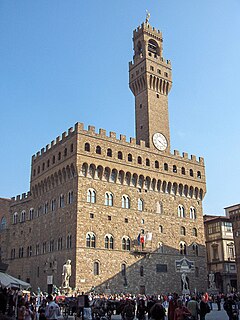
The Palazzo Vecchio is the town hall of Florence, Italy. It overlooks the Piazza della Signoria, which holds a copy of Michelangelo's David statue, and the gallery of statues in the adjacent Loggia dei Lanzi.

The Palazzo Pitti, in English sometimes called the Pitti Palace, is a vast, mainly Renaissance, palace in Florence, Italy. It is situated on the south side of the River Arno, a short distance from the Ponte Vecchio. The core of the present palazzo dates from 1458 and was originally the town residence of Luca Pitti, an ambitious Florentine banker.

The Villa Farnesina is a Renaissance suburban villa in the Via della Lungara, in the district of Trastevere in Rome, central Italy.

The Palazzo Spada is a palace located on Piazza di Capo Ferro #13 in the rione Regola of Rome, Italy. Standing very close to the Palazzo Farnese, it has a garden facing towards the Tiber river.

Ferentillo is a comune (municipality) in the Province of Terni in the Italian region Umbria, located about 60 km southeast of Perugia and about 12 km northeast of Terni. The comune, located in the valley of the Nera, is divided by the river into the burghs of Matterella and Precetto.
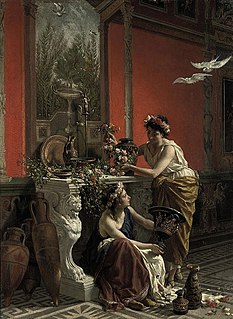
Cesare Mariani was an Italian painter and architect of the late-19th century, active in Rome and Ascoli Piceno.
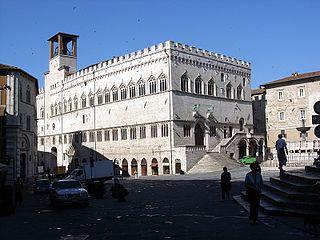
The Palazzo dei Priori or comunale is one of the best examples in Italy of public Palace of the età comunale. It is in the central Piazza IV Novembre in Perugia, Umbria. It extends along Corso Vannucci up to Via Boncambi. It’s still the seat of a part of the town hall and, on the third floor, it’s the seat of the Galleria Nazionale dell’Umbria. It takes its name from the Priori, the highest political authority, who governed the city in the medieval era.
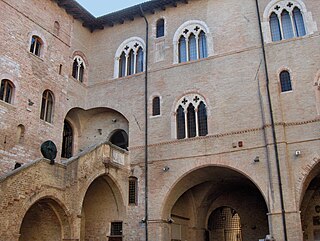
The Trinci Palace is a patrician residence in the center of Foligno, central Italy. It houses an archaeological museum, the city's picture gallery, a multimedia museum of Tournaments and Jousts and the Civic Museum.

Terni Cathedral is a Roman Catholic cathedral in Terni, Umbria, Italy, and the seat of the bishop of Terni-Narni-Amelia. It is dedicated to the Assumption of the Virgin Mary.

The Galleria Spada is a museum in Rome (Italy), which is housed in the Palazzo Spada of the same name, located in the Piazza Capo di Ferro. The palazzo is also famous for its façade and for the forced perspective gallery by Francesco Borromini.

Piazza d'Aracoeli is a square of Rome (Italy), placed at the base of the Capitoline Hill, in the Rione X Campitelli.
Michelangelo Spada was an Italian painter in Verona. He should not be confused with the 16th century Count Michelangelo Spada of Terni who was chamberlain of Pope Julius III.
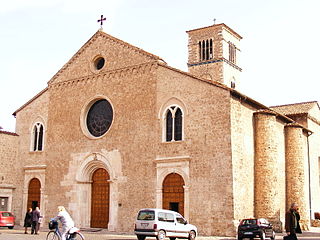
The church of San Francesco is a late-Romanesque and early-Gothic-style, Roman Catholic church and convent in the town of Terni, region of Umbria, in Italy.

Palazzo D'Anna Viaro Martinengo Volpi di Misurata, also known as Palazzo Talenti D'Anna Volpi, is a Renaissance palace in Venice, Italy, located in the San Marco district, overlooking the left side of the Grand Canal, between Palazzo Tron and Casa Marinoni and opposite of Palazzo Donà a Sant'Aponal.



















